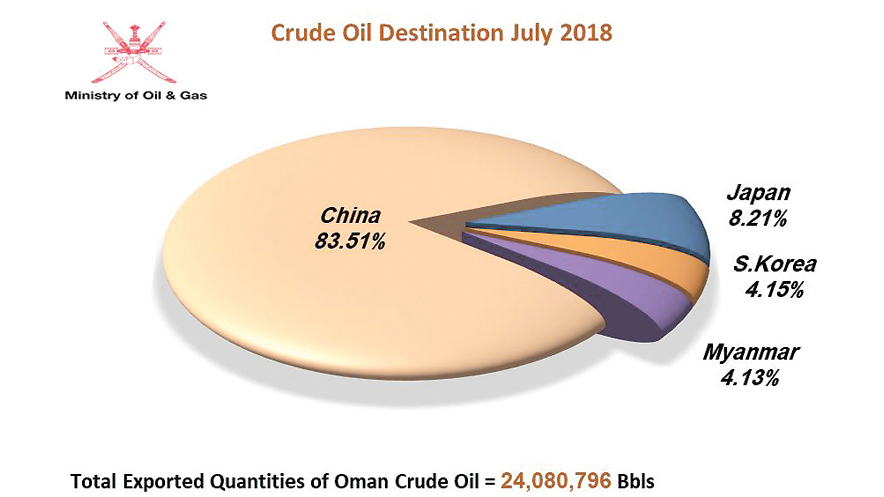

China retained its dominant position as the leading destination for Omani crude exports in July, the Ministry of Oil and Gas (MOG) stated in its monthly report. Of total exports of 24.080 million barrels during the month, China’s share was 83.51 per cent, representing a negligible 0.04 per cent decline over the previous month’s figure.

In contrast, imports by Japan climbed 2.30 per cent, on a month-to-month (m/m) basis, compared to June imports. On the other hand, imports during July were marked by the return of demand for Omani crude to buyers in South Korea (4.15 per cent) and Myanmar (4.13 per cent).
Production of crude oil and condensate in July 2018 amounted to 30.240 million barrels, representing a daily average of 975,500 barrels. Of this total, 24.080 million barrels were exported, representing a daily average of 776,800 barrels.
Prices of crude oil futures witnessed a fallback during July 2018 compared with June 2018 for the major crude oil benchmarks around the world. The average North Sea Brent mix at the Intercontinental Exchange (ICE) in London reached $74.95, down by $0.99. The average price of West Texas Intermediate crude oil at the New York Mercantile Exchange (NYMEX) amounted to $69.50, up $2.36 compared with June 2018.
Based on the same trend, the average price of Oman Crude Oil Future Contracts on the Dubai Mercantile Exchange (DME) dropped 0.6 per cent compared to the previous month. The official selling price for Oman Crude Oil during July 2018, for the delivery month of September 2018, settled at $73.17, which was lower by 0.44 compared with June trading prices. The trading price ranged between $76.11 and $69.71 per barrel.
The crude oil price downtrend through July 2018 was attributed to several factors that negatively affected the prices, including the production hikes in Saudi Arabia and Russian after the meeting of the Organization of the Petroleum Exporting Countries (Opec) with non-member producers in June, which resulted in a decision to gradually ease the group’s production in order to balance the supply and demand of global crude oil.
Also, the oil markets have been squeezed by the escalating trade dispute between the United States of America and China. Where these trade tensions threaten the volume of China’s import of US crude oil. In addition, Libya reopened some of the closed oil ports, which raised the market expectations of the growth of oil supplies. The negative trend in oil prices also harmed by the rise of the dollar exchange rate, which leads to the weakening of other commodities priced in the US currency, such as crude oil.
Oman Observer is now on the WhatsApp channel. Click here



